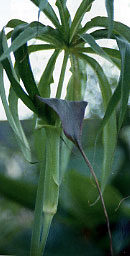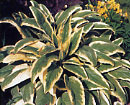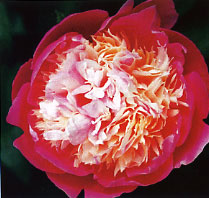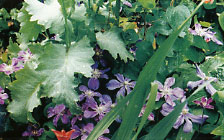![]()
Articles by Deborah Begley
In December 2004, the editor of The Irish Garden, Irelands best selling garden magazine, approached me and asked if I would like to write a series of monthly pieces. Having always enjoyed reading about plants and gardening, it seemed like a fun idea to try my hand at writing about them for a change, so I agreed. Since then I have been writing pieces on seasonal plants and tasks for two pages, entitled Flowers, Borders and Containers. In addition, the magazine has also featured three more, much lengthier articles, during the summer of 2005. These covered aspects such as ornamental gardening and plant profiles. Here are a few samples of my work……
March
| Hellebores are still going strong in March, and considering that they have been giving pleasure since early January there’s no mystery as to their increasing popularity. These plants should be in everybody’s garden, but beware, once bitten by the Hellebore bug you will feel an overwhelming urge to own more. An excellent way to get extra plants at no cost is to raise your own from seed. For this you won’t need pots or greenhouses, just a bucket of fluffy compost or rotted manure. Spread on the ground around the plant this will provide a perfect habitat for the seeds when they fall in the summertime. Mother Nature will do the rest, providing you with countless baby Hellebores next spring! |  |
| Meet Marlene. She’s a dreamy little Primula who is looking really good right now. Each enchanting double bloom is surrounded by a ruff of leaflets which gives rise to it’s common name ‘jack-in-the-green’. Primulas come in many shapes and forms and are an exceptionally rewarding family of plants to grow. Primroses (each flower is carried on a separate stalk) and polyanthus (clusters of flowers borne on one stalk) are available in a multitude of colours and being so cheap and cheerful they can be planted in abundance. A moist, fertile soil and division every year or two is all the care that these early risers need, and best of all being perennial they’ll be back to greet you every spring. |  |
April
| Hostas are looking really luscious now but they are high maintenance plants as slugs adore them and us gardeners need to stay sharp witted if we are to get the better of the slime brigade. For the organically minded of you, try a ring of very sharp grit around each plant, but beware of flicking soil onto it when working nearby as the dastardly creatures are sure to skulking close by, ready to slink across that newly made bridge to their favourite restaurant. A more sure fire but deadly method favoured by those of us determined to keep our leaves intact is to apply diluted liquid slug killer on and around the plants once a month. See photo for results! |  |
Be they pretty or practical, most plants are in the garden for a reason. They create a barrier against wind, hide an eyesore, cover large expanses of potentially weedy soil, produce flowers for cutting or when planted in groups merge together to form a tapestry of colour. And whilst these reasons are all very agreeable, what about excitement? How many plants in your garden make you stop in your tracks and say ‘Wow’! These heart-quickening moments are what makes gardening so worthwhile. Arisaemas look ‘otherworldly’ and are enough to send a shiver of pleasure down any spine! Plant Arisaema consanguineum or Arisaema candidissimum in any moist, well drained, shady spot and prepare to marvel at one of natures wonders |
 |
May
| Large glazed pots make great garden features, but there’s always the dilemma – should they be planted up or used purely as ornaments? To a plant hungry gardener an empty pot feels like a missed opportunity, so here’s an idea for a compromise. Making sure to have drainage holes, fill to half way with a soil-based compost and plant some ferns such as the maidenhair, hart’s tongue and soft shield ferns. Ensure all your choices are low growing and do not produce runners. You have now created a low maintenance microclimate for these plants and if you fancy you could introduce a small ornament, such as a fairy or a mouse. Voila, your ornamental pot now has an extra dimension. |
|
| “Move over flowers, and let some foliage into this garden”, you can almost hear this striking variegated comfrey, Symphytum ‘Axminster Gold’ mutter. All too often the success of a garden seems to be judged by the amount of flowers produced during the summer, with foliage relegated to ‘poor cousin’ status. But with leaves like these, who needs flowers? The next time you visit a garden centre, try looking at the leaves instead of the blooms, you may be in for a pleasant surprise. And remember, foliage is the clothes that your garden wears, whilst the flowers are just the jewellery and perfume added as the finishing touch. Sure even Adam knew that way back then when he grabbed that fig leaf…. |  |
June
| Mmmmm… a Raspberry Sundae on a hot June day, wonderfully scrumptious and being a Peony, there’s not a single calorie to spoil the figure! These, along with all the other P.lactiflora hybrids, bear opulent, fragrant blossoms for a few weeks in early summer and are best planted in mixed borders where they associate well with roses, campanulas and geraniums. Easily pleased, herbaceous Peonies have been in cultivation for over a thousand years. Grow them in sun or semi-shade in a fertile, heavy soil and ensure that the dormant buds are never planted deeper than 2” below the soil level as this will inhibit the production of flowers. These beauties are guaranteed to add a certain ‘je ne sais quoi’ to any garden! |  |
Not all Clematis want to reach for the skies, some are happy to mooch around at ground level, weaving their flowery shoots through the borders. The variety ‘Arabella’ makes a delightful companion to clumps of late flowering perennials such as Crocosmias, filling the green leafy areas with its pretty lilac flowers in early summer. Other species that will do a similar job are C. integrifolia, available in pink, blue or white forms, C. x durandii (deep blue) and C. eriostemon with pretty purple blooms. The added beauty of these ground-covering Clematis is the simplicity of their pruning, just cut back the top growth to the first set of plump buds in late February and the flowers will be carried on the new stems. |
 |
To look at more Click Here
Home About Us Photographs Reviews Articles Events Plants Seeds Location Links